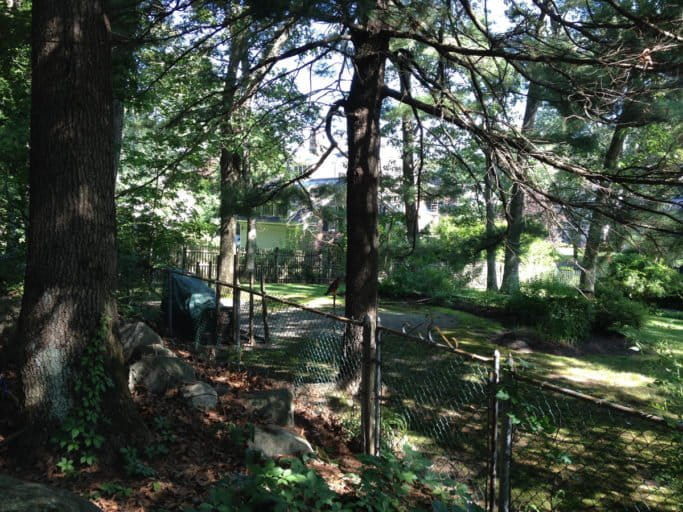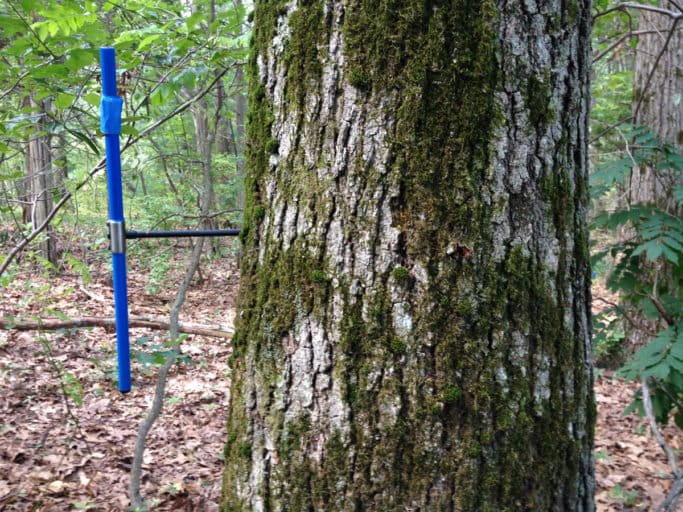- A study published in the journal Proceedings of the National Academies of Science reports that trees on the edges of temperate forests in eastern Massachusetts grow nearly 90 percent faster than those on the interior, in contrast with the declines documented in tropical and boreal forest edges.
- The increased growth rates and biomass production could translate into a 13-percent boost in carbon uptake and a 10-percent bump in carbon storage over current estimates in the region.
- However, these edges are more sensitive to higher temperatures, and as the climate warms, their growth rates will likely drop off more quickly than those further into the forest.
Scientists and conservationists worry about the cascade of detriment that results from slicing up blocks of forest, especially as the amount of intact forest dwindles globally. But recent research published in the Proceedings of the National Academy of Sciences indicates that we might be underestimating the positive impacts that fragmentation can have in certain places, particularly on how much carbon the newly created edges pull from the atmosphere.
The effects of fragmenting forests are as far-ranging as they are almost entirely negative. Forests that fall to make way for settlements, agriculture and pastureland splinter wildlife habitats and isolate already-threatened or -endangered species. A 2015 study, which concluded that 70 percent of all forest worldwide is only a kilometer (0.62 miles) from its edge, demonstrated the compounding effect of fragmentation over time: In some cases, fragmentation halved the number of plant and animal species present in 20 years.
But, it turns out, the story for carbon storage is different, at least in the temperate forests of Massachusetts.

“Our typical thinking would have been, if you lose half of the forest on the landscape, you lose half of your carbon sink,” said Andy Reinmann, a forest ecologist and biogeochemist and lead author of the paper. “It’s not quite that simple.”
An earlier investigation led by Reinmann’s colleague Brittain Briber revealed that oak trees at the boundaries of spots where forest had recently been cleared for urban development grew much faster than before.
That discovery contradicts a lot of what we know about forests from other parts of the world. In the Amazon, for example, wood production and carbon uptake decrease along these borders.
“That got us thinking, well, is this just restricted to these individual trees right on the edge?” Reinmann told Mongabay. And they were curious about how far into the forest this effect stretched and if it would have a significant effect on the dynamics of carbon.
To answer those questions, they set up research plots in the oak-dominated forests of eastern Massachusetts. It’s an ideal field laboratory to explore the ramifications of fragmentation because roads, agriculture and urban development keep the region’s forest in pieces. And yet, if you could go back in time a few hundred years, before European colonization, you’d find a more or less solid block of forest.

The team measured tree diameters, collected soil samples and drilled cores from the larger oak trees on the plots. They then used the widths between the tree rings to deduce how quickly the trees grew, cross-referencing that information with temperatures and rainfall recorded between 1990 and 2014.
From their statistical analysis, they found that the forest edge was growing 89 percent faster than the trees found 30 meters (98.5 feet) further in. And there was 64 percent more organic material, or biomass, at the forest edge.
Those increases in productivity don’t jibe with what happens when fragmenting forest creates an edge in a place like the Amazon rainforest. But coauthor Lucy Hutyra, an associate professor of earth and environment at Boston University, said that it wasn’t surprising when she thought about the unique characteristics of and history of human use in these temperate forests.
At the fringes of a forest, trees are exposed to more light and the competition for nutrients isn’t as fierce as it is for trees on the interior, which in fact form “the basis of a lot forestry practices,” she said. We humans will “thin” forests when we want certain trees to grow faster, and creating an edge accomplishes much the same result, she said.
“The really surprising part for me was the magnitude of the effect on the regional carbon balance,” Hutyra said.
By their calculations, current calculations, which don’t take this edge effect into account, underestimate how much carbon the region’s forests can take up by about 13 percent and the amount they can store by 10 percent because of these edge effects.

A forest of a different color
“It’s an interesting result in that it’s counter to what other people have found,” said Bill Laurance, a tropical ecologist at James Cook University in Cairns, Australia, who was not involved in the research.
Until now, much of the research that has looked at fragmentation has been focused on the Amazon rainforest and other areas in the tropics, including “seminal work” by Laurance and his colleagues in the 1990s and 2000s, Hutyra said.
Hutyra and Reinmann’s research reveals that the differences between tropical rainforests and the temperate forests of southern New England translate into different responses to fragmentation.
The tall, top-heavy trees of the tropics, which keep their leaves year-round, “act like sails to catch the wind,” Reinmann said. And the opportunistic vines winding their way in rainforests can compound the problem, pulling down neighboring trees.
The deciduous oaks and other trees in Massachusetts, by contrast, are shorter and thicker-bodied with deeper roots, meaning they won’t fall over as easily.
In addition to the mechanisms at play, these temperate forests face fewer conservation challenges.
“This is a system that’s recovering, not a system that’s declining,” said Laurance. “They’ve hit rock bottom and now they’re rebounding.
“Their systems are probably less sensitive to being fragmented than a tropical rainforest is,” Laurance added.
Forests once covered nearly all of eastern Massachusetts, but dipped to less than a third of the land area by the 1800s as European colonists cleared the land for agriculture. Since then, forest cover has recovered to about half of the region, write the authors.
Still, Reinmann and Hutrya are quick to point out that their findings aren’t justification to carve up standing forests just to create more prolific edges.
“Even though we find that these forest edges are maybe more productive than the interior,” Reinmann said, “it’s not more productive enough to offset the forest that had to be lost to create that edge.”
And in another key finding, they predict that these edges will be more susceptible to rising temperatures through the end of the century. As a result, the growth rates of these forest fringes will decline more quickly than the remainder of the forest.
Forest fragmentation is “still a clear net negative,” Hutyra said. “If the edge had never been created, we’d be better off.”
Editor’s note: William Laurance is a member of Mongabay’s advisory board.
CITATIONS:
- Briber, B. M., Hutyra, L. R., Reinmann, A. B., Raciti, S. M., Dearborn, V. K., Holden, C. E., & Dunn, A. L. (2015). Tree productivity enhanced with conversion from forest to urban land covers. PLOS ONE, 10(8), e0136237.
- Haddad, N. M., Brudvig, L. A., Clobert, J., Davies, K. F., Gonzalez, A., Holt, R. D., et al. (2015). Habitat fragmentation and its lasting impact on Earth’s ecosystems. Science Advances, 1(2), e1500052.
- Reinmann, A. B., & Hutyra, L. R. (2016). Edge effects enhance carbon uptake and its vulnerability to climate change in temperate broadleaf forests. Proceedings of the National Academy of Sciences, 201612369.
Banner image of meadow edge by Ian Smith.
